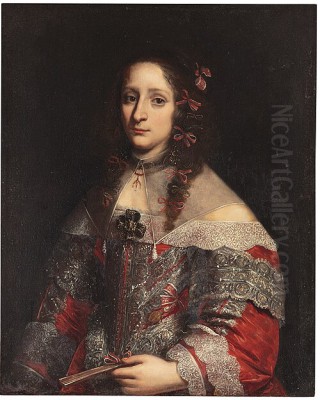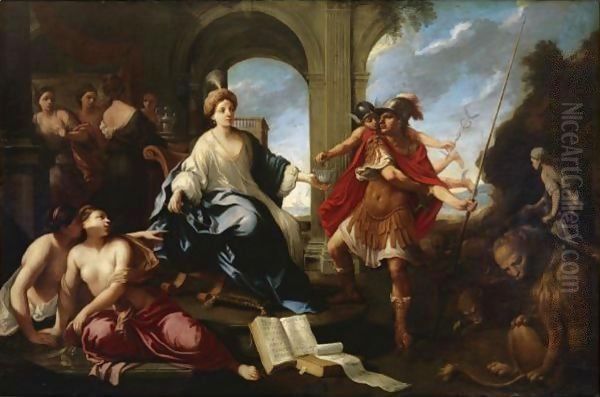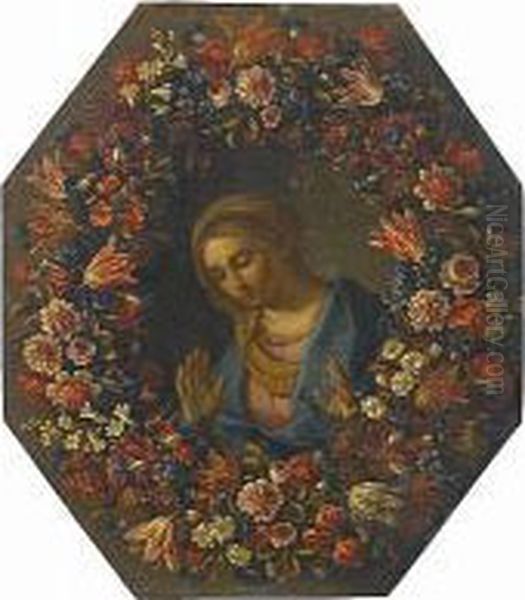
Pier Francesco Cittadini, often known as "Il Milanese" due to his origins, stands as a significant figure in the vibrant tapestry of Italian Baroque art. Born in Milan in 1616, his artistic journey led him to Bologna, the city that would become the primary stage for his long and productive career, which lasted until his death in 1681. Cittadini navigated the rich artistic currents of his time, developing a distinctive style that encompassed religious scenes, portraiture, landscapes, and, most notably, still life painting. His ability to absorb influences, from the Lombard naturalism of his youth to the classical idealism of his Bolognese master and the international trends encountered in Rome, allowed him to forge a unique artistic identity.
Early Life and Formative Training
Cittadini's artistic education began in his native Milan, a major artistic center in Lombardy. His initial training was under the guidance of Daniele Crespi (c. 1598–1630), a prominent Lombard painter known for his sober realism and dramatic intensity, characteristics deeply rooted in the region's artistic traditions, which looked back to figures like Caravaggio. This early exposure to Lombard naturalism likely provided Cittadini with a solid foundation in depicting figures and objects with truthfulness and directness.
However, the lure of Bologna, a powerhouse of Italian painting in the 17th century, proved strong. Around the age of 17, Cittadini made the pivotal decision to relocate. Bologna was dominated by the legacy of the Carracci family – Ludovico, Agostino, and Annibale Carracci – whose academy had revitalized painting by emphasizing drawing from life and synthesizing Renaissance classicism with Venetian colorism. By the time Cittadini arrived, the leading figure was Guido Reni (1575–1642), himself a product of the Carracci Academy but renowned for his elegant, idealized figures and refined classical style.
Under the Guidance of Guido Reni
Entering Guido Reni's bustling workshop was a transformative experience for the young Cittadini. Reni was at the height of his fame, receiving prestigious commissions from across Italy and Europe. Working in this environment exposed Cittadini to the highest standards of Bolognese classicism. Reni's emphasis on graceful composition, delicate colour palettes, and the depiction of idealized beauty left an indelible mark on his pupil.

Evidence of Reni's direct influence can be seen in Cittadini's early works executed in Bologna during the 1630s. Religious compositions from this period, such as the Stoning of St. Stephen (1637), the Flagellation, and the Crowning with Thorns, clearly demonstrate his assimilation of Reni's style. These works exhibit a clarity of composition, a controlled emotional tenor, and a rendering of figures that echoes the master's approach, albeit perhaps with a lingering Lombard robustness from his earlier training. He successfully established himself within the competitive Bolognese art scene during this initial phase.
The Bolognese Artistic Milieu
Beyond the direct tutelage of Reni, Cittadini operated within a rich artistic ecosystem in Bologna. The city remained a hub of creativity, with numerous artists contributing to its reputation. Figures like Francesco Albani (1578–1660) and Domenichino (1581–1641), both also trained by the Carracci, continued to champion different facets of the classical tradition. Guercino (1591–1666), though largely based in nearby Cento before moving to Bologna after Reni's death, was another major force known for his dynamic Baroque style and masterful use of chiaroscuro.
Furthermore, Cittadini would have been aware of, and likely influenced by, local specialists. Bolognese artists like Evaristo Baschenis (though primarily active in Bergamo, his work was known) and Bartolomeo Bettera (also from Bergamo but whose style relates to Lombard and Bolognese still life) were developing distinctive forms of still life painting, particularly focusing on musical instruments and opulent displays. Simone Cantarini (1612–1648), known as "Il Pesarese," another pupil and later rival of Reni, was also active during Cittadini's early years in Bologna, known for his spirited etchings and paintings. This environment provided both inspiration and competition.
The Roman Sojourn and Stylistic Expansion
A crucial period in Cittadini's development occurred in the mid-1640s when he traveled to Rome. The papal city was the undisputed center of the Baroque, attracting artists from all over Europe. This journey significantly broadened Cittadini's artistic horizons. In Rome, he encountered a melting pot of styles and influences far exceeding what was available even in Bologna. He came into contact with the works of leading Italian masters like Pietro da Cortona, known for his exuberant ceiling frescoes, and sculptors like Gian Lorenzo Bernini.

Critically, Cittadini also interacted with the burgeoning community of foreign artists active in Rome. French painters such as Nicolas Poussin and Claude Lorrain were establishing classical landscape painting, while Flemish and Dutch artists brought their own traditions of realism, genre painting, and still life. Figures like Pier Francesco Mola (1612–1666), originally from the Swiss-Italian border region but active in Rome, and Pietro Testa (1611–1650), known for his complex allegorical etchings and paintings, were part of the dynamic Roman scene Cittadini experienced. This exposure seems to have encouraged Cittadini to diversify his subject matter and perhaps incorporate elements of Northern European detail and finish into his work, particularly his still lifes and landscapes. Works like Lot and his Daughters and Hagar and the Angel, painted for the church of San Giovanni in Monte in Bologna, likely reflect the broadened perspective gained during his time in Rome.
Master of Still Life
While proficient in various genres, Pier Francesco Cittadini earned particular renown for his still life paintings. Returning to Bologna after his Roman interlude, he increasingly dedicated himself to this genre, developing a style that blended Lombard realism, Bolognese structure, and possibly Flemish influences absorbed in Rome. His still lifes often feature arrangements of fruit, flowers, game, and luxurious objects, depicted with meticulous attention to texture, colour, and the play of light.
His compositions range from intimate studies to more elaborate displays. Common subjects include bowls overflowing with grapes, peaches, and figs, often accompanied by flowers like tulips and roses, arranged on stone ledges or draped tables. He excelled at rendering the varied surfaces of these objects – the fuzzy skin of a peach, the translucent gleam of grapes, the delicate petals of a flower, or the soft fur of hunted game. Works like Still Life With Hare (c. 1650) exemplify his skill in this area, capturing the textures of the animal's fur alongside fruit and foliage.
Cittadini's still lifes often possess a decorative quality, reflecting the tastes of his patrons for images that conveyed abundance and the beauty of nature. Unlike some Northern European vanitas paintings, which heavily emphasize themes of mortality and the transience of life, Cittadini's works generally celebrate the richness and sensuous appeal of the natural world, though a subtle awareness of time's passage may sometimes be inferred. His ability to organize complex arrangements into harmonious compositions, balancing colour and form, marks him as a leading practitioner of the genre in 17th-century Italy.
Portraiture and Figurative Works
Alongside his still lifes, Cittadini maintained a practice in portraiture. His portraits often depict members of the Bolognese aristocracy and bourgeoisie, capturing not only their likeness but also their status through careful attention to clothing, accessories, and setting. The Portrait of a Lady with her Daughter and Page is a fine example, showcasing his ability to handle complex figure compositions and render luxurious fabrics with precision. The psychological portrayal tends towards a dignified reserve characteristic of formal portraiture of the period, but the naturalistic detail grounds the figures in reality.
He continued to produce religious and mythological paintings throughout his career, although perhaps less frequently than in his youth under Reni. The Conversion of St. Paul, painted for the church of Santo Stefano in Bologna, demonstrates his continued engagement with large-scale narrative compositions. A later work sometimes attributed to him or his circle, Circe (often dated post-mortem, possibly indicating a workshop piece or inventory date), explores a mythological theme, depicting the sorceress known from Homer's Odyssey. These works allowed him to utilize the figure-painting skills honed under Reni, adapted to his mature style.
Collaborations and Decorative Projects
Cittadini's talents extended to decorative projects, often undertaken in collaboration with family members. He worked with his brothers, particularly Carlo Cittadini, on decorative schemes. A notable example is their work in the Ducal Palace of Sassuolo, near Modena, residence of the Este dukes. There, they contributed to the decoration of the Bacchus Room (Camera di Bacco), creating frescoes that included ornate frames adorned with painted grapes and fruits, surrounding central scenes. They also reportedly painted allegories of the Four Seasons. These projects highlight Cittadini's versatility and his ability to work within the context of large-scale Baroque interior decoration, integrating figurative elements with still life motifs.
Later Career, Workshop, and Family Legacy
Having established a successful career, Cittadini maintained an active workshop in Bologna for several decades. His reputation attracted commissions, and his diverse output found favour with collectors. His artistic legacy was also carried on by his family. Two of his sons, Giovanni Battista Cittadini (sometimes called Gianbattista) and Carlo Cittadini (sharing the name of Pier Francesco's brother), followed in his footsteps, becoming painters themselves, primarily specializing in still life. This continuation of the family trade underscores the workshop practices common in the era and suggests that Pier Francesco passed on his skills and stylistic preferences to the next generation. His influence can be seen in the work of other Bolognese still life painters active in the later 17th century.
Artistic Style and Technique Summarized
Pier Francesco Cittadini's style is characterized by its synthesis of diverse influences. The naturalism inherited from his Lombard training provided a foundation for realistic depiction. The classicism absorbed from Guido Reni imparted elegance, compositional clarity, and idealized forms, particularly visible in his figurative work. His Roman experience introduced a broader range of subject matter and potentially a greater richness or detail influenced by Northern European art.
Technically, he demonstrated considerable skill. His handling of paint allowed him to convincingly render a wide variety of textures. His use of light and shadow (chiaroscuro), while perhaps less dramatic than that of Caravaggio or Guercino, effectively models forms and creates atmosphere. His colour palettes could range from the refined and delicate tones reminiscent of Reni to richer, more saturated hues appropriate for opulent still lifes. Compositionally, his works are generally well-balanced and thoughtfully arranged, whether depicting a complex narrative scene, a formal portrait, or an intricate still life display.
Historical Significance and Legacy
Pier Francesco Cittadini holds a secure place within the history of Italian Baroque art, particularly within the Bolognese school. While perhaps overshadowed in figurative painting by giants like Reni or Guercino, he carved out a significant niche as a versatile artist highly accomplished in multiple genres. His most enduring contribution lies in the field of still life painting, where he ranks among the important Italian practitioners of the 17th century. His works in this genre successfully blended decorative appeal with convincing naturalism.
His paintings are held in numerous museums and private collections across Italy and internationally. The story of his Still Life With Hare, looted during World War II, restituted, and later involved in diplomatic exchange between Georgia and Germany, highlights the complex afterlife that artworks can have and underscores the enduring value placed upon his creations. Cittadini's career exemplifies the rich artistic production of Bologna during the Baroque period and demonstrates how an artist could successfully navigate and synthesize the major artistic currents of his time – Lombard realism, Bolognese classicism, Roman grandeur, and international influences – to create a distinctive and lasting body of work. He remains a testament to the depth and diversity of talent flourishing in 17th-century Italy.